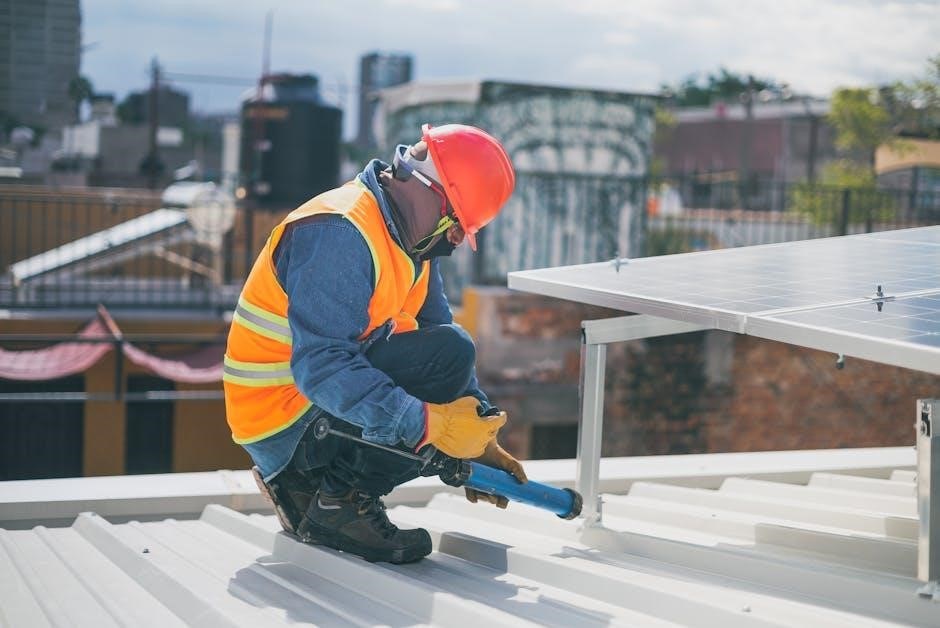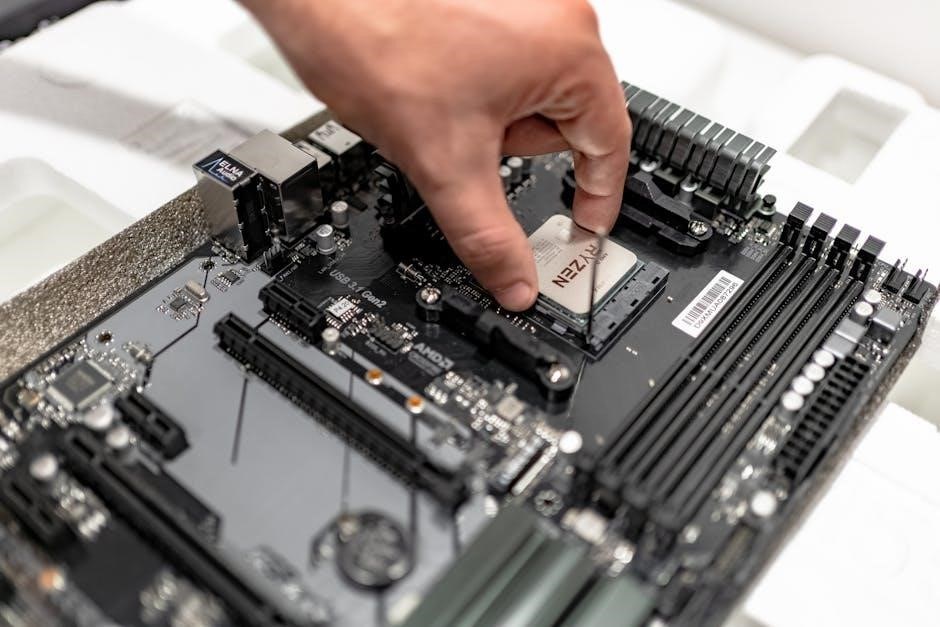The Honeywell Pro 6000 Thermostat is a programmable digital thermostat designed for precise temperature control and energy efficiency. It offers customizable settings and compatibility with various HVAC systems, making it a versatile solution for home comfort. This manual provides a comprehensive guide for installation, configuration, and troubleshooting to ensure optimal performance.

1.1 Overview of the Honeywell Pro 6000 Series
The Honeywell Pro 6000 Series is a line of programmable digital thermostats designed to provide precise temperature control and energy efficiency for home HVAC systems. These thermostats are known for their intuitive interface and customizable features, allowing users to tailor settings to their comfort preferences. The series includes models such as the TH6110D, TH6220D, and TH6320U, each catering to different system configurations, including 1 Heat/1 Cool and 2 Heat/2 Cool setups. With advanced features like programmable scheduling and energy-saving modes, the Pro 6000 Series is a reliable choice for modern homes seeking efficient temperature management.
1.2 Key Features and Benefits
The Honeywell Pro 6000 Thermostat offers several key features that enhance its functionality and user experience. It includes programmable scheduling, allowing users to set temperature preferences for different times of the day. The thermostat also supports energy-saving modes, helping reduce energy consumption and lower utility bills. With compatibility across various HVAC systems, including heat pumps and dual-fuel setups, it ensures versatile installation options. Additionally, its intuitive interface makes it easy to navigate and customize settings, while features like compressor protection and emergency heat functions provide reliable performance and safety for your home’s heating and cooling system.

System Requirements and Compatibility
The Honeywell Pro 6000 Thermostat is compatible with 24VAC heating and cooling systems, including heat pumps and dual-fuel setups. It supports single or multi-stage systems and requires proper zoning configurations for optimal performance.
2.1 Compatible Heating and Cooling Systems
The Honeywell Pro 6000 Thermostat is designed to work with a variety of heating and cooling systems, including gas furnaces, heat pumps, and air conditioning units. It supports single-stage, two-stage, and multi-stage systems, ensuring compatibility with most residential HVAC setups. The thermostat is also compatible with dual-fuel systems, which combine a heat pump with a furnace for efficient heating. Additionally, it can be integrated with zoning systems, allowing for customized temperature control in different areas of the home. Proper system configuration ensures optimal performance and energy efficiency.
2.2 Necessary Tools and Materials for Installation
For a successful installation of the Honeywell Pro 6000 Thermostat, you will need specific tools and materials. Essential tools include a screwdriver (both Phillips and flathead), wire strippers, and a voltage tester to ensure safe electrical work. Materials required include the thermostat unit, wallplate, mounting screws, and any additional jumper wires for system compatibility. Ensure all components are compatible with your HVAC system type, such as heat pumps or dual-fuel systems. Refer to the installation manual for specific requirements based on your system configuration to avoid errors during setup.

Physical Installation of the Thermostat
Begin by removing the wallplate from the thermostat and pulling it away to access the wiring. Remove the battery holder to prevent accidental power activation. Mount the wallplate securely, ensuring proper alignment for accurate temperature sensing and system control.
3.1 Wallplate Preparation and Mounting
Start by detaching the wallplate from the thermostat to access the wiring. Gently pull the wallplate away to ensure it is fully removed. Next, take out the battery holder to prevent any accidental power activation during installation. Locate the mounting area and ensure it is level for proper installation. Align the wallplate with the screws or clips provided, making sure it is securely fastened to the wall. Avoid bending or forcing the wallplate, as this could damage the thermostat. Once mounted, verify that the wallplate is stable and properly aligned for accurate temperature sensing and system control.

3.2 Wiring Connections and Setup

Ensure the power to your HVAC system is turned off before proceeding. Carefully match the wires from your existing system to the corresponding terminals on the Honeywell Pro 6000 thermostat. Refer to the wiring guide provided in the manual to identify the correct connections for your specific setup. Gently secure the wires to the terminals, ensuring they are tightly connected to avoid loose connections. Once all wires are properly connected, replace the wallplate and restore power. Test the system to ensure all functions operate correctly. If you encounter any issues, consult the troubleshooting section or contact Honeywell support for assistance.
Configuring the Thermostat Settings
Configure the Honeywell Pro 6000 thermostat by selecting your HVAC system type, setting temperature ranges, and customizing schedules for energy efficiency. Adjust settings as needed for optimal performance.
4.1 Setting Up the Thermostat for Your HVAC System
The Honeywell Pro 6000 thermostat is designed to work with various HVAC systems, including heat pumps, dual-fuel systems, and traditional heating/cooling setups. Begin by selecting the appropriate system type in the thermostat menu to ensure proper operation. For heat-only or cool-only systems, choose the corresponding mode. If using a heat pump, enable the auxiliary heat option. Dual-fuel systems require configuring the thermostat to switch between gas and electric heat sources. After selecting your system type, set the compressor protection time and emergency heat settings if applicable. Finally, test the system to ensure all components function correctly. This step ensures optimal performance and energy efficiency tailored to your specific HVAC setup.
4.2 Customizing Features for Energy Efficiency
The Honeywell Pro 6000 thermostat offers advanced features to optimize energy usage. Program schedules to align with your daily routine, reducing energy waste when the house is unoccupied. Enable energy-saving modes to cap heating or cooling at efficient setpoints. The smart recovery feature ensures the system reaches your desired temperature just before your scheduled time, avoiding unnecessary runtime. Additionally, adjust the temperature differential to prevent frequent cycling, and set limits for maximum and minimum temperatures to maintain efficiency. These customizable settings help reduce energy consumption while maintaining comfort, ensuring cost savings and environmental benefits. Regular updates and system monitoring further enhance efficiency.
Testing and Verification
Test heating, cooling, and emergency heat functions to ensure proper operation. Verify thermostat responses to temperature changes and system compatibility. Follow manual procedures for accurate verification.
5.1 Testing Heating, Cooling, and Emergency Heat Functions
After installation, test the Honeywell Pro 6000 by running the heating, cooling, and emergency heat functions. Start by switching the thermostat to “Heat” and check if the heating system activates. Verify the temperature rise and ensure the system cycles correctly. Repeat the process for “Cool” to confirm the cooling system operates as expected. For emergency heat, activate the mode and monitor the system’s response. Ensure the thermostat transitions smoothly between modes and maintains the set temperature. If any issues arise, refer to the manual for troubleshooting steps to resolve them effectively.

Troubleshooting Common Issues
Common issues include no display, incorrect temperature readings, or system malfunctions. Check wiring connections, battery levels, and system compatibility. Refer to the manual for detailed solutions and diagnostic guides to resolve these problems effectively.
6.1 Diagnosing and Resolving Installation Problems
During installation, issues like wiring misconnections or improper wallplate mounting may occur. Check for loose wires, ensure correct terminal connections, and verify battery installation. If the display remains off, confirm power is supplied and batteries are correctly inserted. Consult the manual for wiring diagrams and compatibility checks. For system malfunctions post-installation, test heating, cooling, and fan functions separately. Reset the thermostat or perform a factory reset if necessary. Ensure all system components are compatible with the Honeywell Pro 6000 to avoid operational conflicts. Refer to the troubleshooting section for detailed solutions and diagnostic steps to resolve installation-related problems effectively.

Maintenance and Upkeep
Regular maintenance ensures optimal performance. Replace batteries annually, clean the display and sensors, and check for firmware updates to keep the Honeywell Pro 6000 operating efficiently;
7.1 Replacing Batteries and Cleaning the Thermostat

Replace batteries annually to ensure uninterrupted operation. Press down on the battery holder and pull to remove it. Use two fresh AA alkaline batteries, ensuring correct polarity. After replacing, reattach the holder securely. Clean the thermostat with a soft cloth and mild detergent, avoiding harsh chemicals. Remove the wallplate for easier access to the display and sensors. Regular cleaning prevents dust buildup, ensuring accurate temperature readings. Refer to the manual for detailed instructions to maintain optimal performance and extend the thermostat’s lifespan.